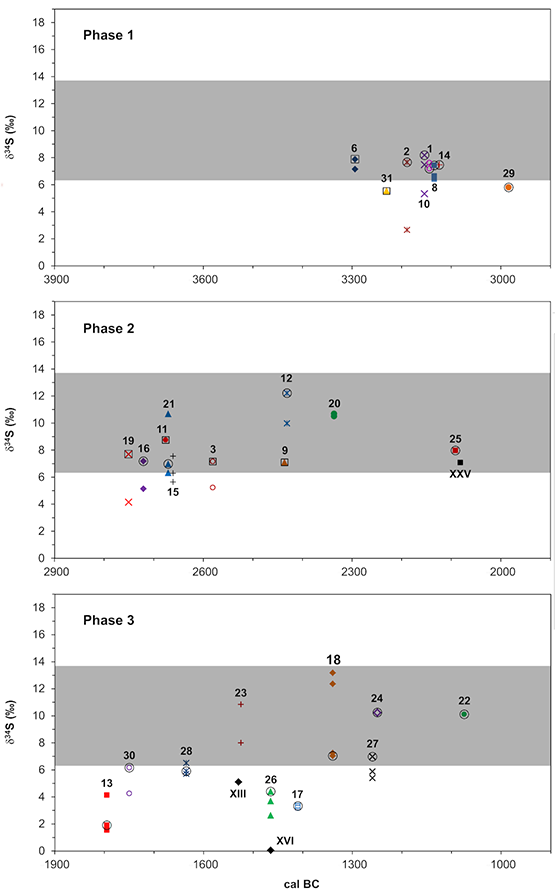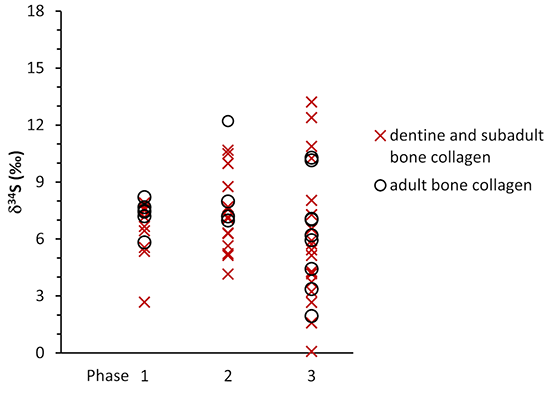
Estimated terrestrial δ34S values for human individuals with marine dietary input below 60% were calculated for 28 individuals from Resmo and three from Torsborg, including intra-individual data for 21 Resmo individuals. These are plotted separately for each phase in Figure 5, where the predicted local terrestrial range is shaded, black circles around symbols mark adult bone samples, black squares around symbols mark subadult bone samples, and the remaining symbols are dentine samples. It is important to remember here that the estimated terrestrial δ34S value reflects only the terrestrial portion of the diet, which enables comparison between individuals and chronological phases with varying levels of marine dietary protein input.

Two aspects of human mobility are considered here: non-local origin and change of residence during the lifetime. Any estimated terrestrial δ34S value outside the local terrestrial range is considered as non-local. For subjects with intra-individual data, the individuals are identified as non-local if at least one value is outside the local terrestrial range. Change of residence is defined as an intra-individual δ34S range exceeding 2‰. This level was chosen with consideration of the ±1 sd ranges for the Rössberga and Frälsegården populations, who were interpreted as homogeneous and likely to be local.
From Torsborg, estimates of the original terrestrial δ34S values, all from dentine, could only be made for the three subjects with terrestrial diets. For the Neolithic individual, the value falls within the local terrestrial range, whereas the two Bronze Age subjects have estimated terrestrial δ34S values well below the local range, indicating a non-local origin.
The estimated terrestrial δ34S values for the 28 Resmo individuals range from +1.6 to +13.2‰, with values extending below the local terrestrial range thus indicating non-local origins. It is obvious from Figure 5 that the ranges increase for each chronological phase, something that was already evident from the observed δ34S values.
During Phase 1, four individuals fall completely within the local terrestrial range (subjects 1, 6, 8 and 14), and none of them have an individual range suggesting any change of residence. Subjects 2 and 10 have non-local values from the earliest formed dentine (reflecting childhood), while later dentine and bone values are within the local terrestrial range. Their individual ranges suggest change of residence and childhoods spent outside of Öland in both cases. The bone value from the infant, subject 31, is also outside the local range, probably reflecting the mother's diet during pregnancy and lactation, as its elevated δ15N indicates that the infant was breastfed. The bone value of subject 29 also supports a non-local origin.
During Phase 2, six individuals fall completely within the local terrestrial range (subjects 9, 11, 12, 20, 21 and 25). There is no detectable difference between the two dentine (childhood) values for subject 20, whereas subjects 12 and 21 have ranges >2‰, indicative of change of residence. For four subjects (3, 15, 16 and 19), dentine (childhood) values are outside the local terrestrial range, whereas tissues formed later in life fall within the local range. Both subjects 16 and 19, an adult and a child, respectively, have individual ranges exceeding 2‰, suggesting change of residence, while the subadult subjects 3 and 15 have smaller individual ranges.
During Phase 3, four adult individuals fall completely within the local terrestrial range (subjects 18, 22, 23 and 24. Two of these, subjects 18 and 23, have intra-individual ranges suggestive of change of residence during the course of life, while the estimated terrestrial δ34S values of subject 24, reflecting early childhood and adult age, are indistinguishable. Four individuals fall completely outside the local terrestrial range (subjects 13, 17, 26 and 30), and another two (subjects 27 and 28) have only one value each inside the local range. Only one out of these six non-local individuals, subject 13, has an individual range indicating change of residence.

In sum, there is an increase in the proportion of individuals classified as non-locals from the Neolithic (Phases 1 and 2), to the Bronze Age (Phase 3) - from 50% and 36% during the Neolithic, to 67% during the Bronze Age. This rise is clearly discernible but by no means remarkable. However, taking into account the overall range of variation for each phase, a clear pattern emerges (Figure 6). The mean estimated terrestrial δ34S value for Phase 1 is +6.7‰, and the standard deviation only 1.4‰ (n=15), while both the mean and the sd increase during Phase 2, to +7.7 ± 2.1‰ (n=20, incl. Torsborg). During Phase 3, the mean is below the local terrestrial range, +6.2‰, and the sd as large as 3.3‰ (n=27, incl. Torsborg). As expected, the subadult values (dentine and subadult bone) vary to a higher degree (both range and sd) than adult values (adult bone), since the former represent shorter tissue formation times, while the longer time of formation in adult bone tends to level out short-term variation such as seasonal differences. It is truly difficult to find a better explanation for the increasing ranges at the population level than increasing mobility.
Internet Archaeology is an open access journal based in the Department of Archaeology, University of York. Except where otherwise noted, content from this work may be used under the terms of the Creative Commons Attribution 3.0 (CC BY) Unported licence, which permits unrestricted use, distribution, and reproduction in any medium, provided that attribution to the author(s), the title of the work, the Internet Archaeology journal and the relevant URL/DOI are given.
Terms and Conditions | Legal Statements | Privacy Policy | Cookies Policy | Citing Internet Archaeology
Internet Archaeology content is preserved for the long term with the Archaeology Data Service. Help sustain and support open access publication by donating to our Open Access Archaeology Fund.
File last updated: Thu Nov 13 2014